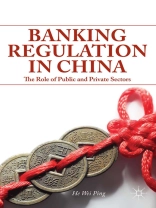Banking Regulation in China provides an in-depth analysis of the country’s contemporary banking regulatory system, focusing on regulation in practice. By drawing on public and private interest theories relating to bank regulation, He argues that controlled development of the banking sector transformed China’s banks into more market-oriented institutions and increased public sector growth. This work proves that bank regulation is the primary means through which the Chinese government achieves its political and economic objectives rather than using it as a vehicle for maintaining efficient financial markets.
Cuprins
1. Introduction 2. Banking Regulatory Theories 3. Banking Regulation in China: Why, What, and How? 4. Regulating the Entry of Foreign Banks 5. Consumer Financial Protection 6. Regulatory Dissonance 7. Regulatory Capture 8. Conclusions
Despre autor
He Wei Ping is a researcher in the area of financial market regulation with a particular focus on Chinese banking and securities markets. She was previously a Lecturer at the University of South Australia s International Graduate School of Business. She holds a Masters in Law from the University of Adelaide Law School, Australia, and a Doctorate from the School of Law at the University of South Australia.












